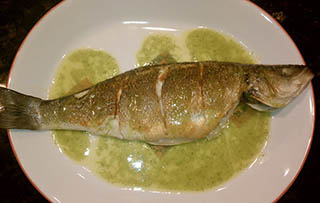Branzino, known as the Italian name for this silver-skinned fish, is highly prized in Mediterranean cuisine for its lean, firm, white, and delicate flesh.
The spotted seabass (Dicentrarchus punctatus) is a close relative found in temperate marine and brackish waters of the eastern Atlantic and the Mediterranean Sea.
Chilean sea bass (Patagonian toothfish) is a distinct species native to coastal waters of Southern Chile and Argentina.
Striped American sea bass (Morone saxatilis) is also a separate species found in the Eastern coastal waters of the United States.
Habitat
European sea bass inhabit coastal waters in small schools, although they are sometimes found in brackish or freshwater environments. They can also be spotted in saltwater lakes, lagoons, and certain large river estuaries. Branzino primarily feeds on small fish, crustaceans, and fish eggs.
Description
Branzino, also known as the European seabass, is a round, warm-water marine fish. It is easily recognizable by its silvery-grey, scaly, elongated body, featuring two separate dorsal fins and rayed anal fins. The anal fin is slightly forked.
Ranging in size from one and a half to three pounds, it boasts a firm, white, delicate-flavored flesh with few small bones. In Italy, sea bass are intensively bred in salty waters.
Adult fish typically measure between 30 to 50 cm in length and weigh between one and a half to three pounds. Commercial farming of sea bass is successfully undertaken on Italian Mediterranean coasts for export to the United States.
Buying
Branzino is readily available year-round in US markets, either as whole fish or fillets. The peak season for freshness is in spring or early summer, prior to spawning. Look for vibrant, firm fish exhibiting silvery skin, pink gills, and clear eyes.
Fresh, wild-caught branzino commands higher prices compared to farm-raised varieties. However, farmed bass offers a more budget-friendly option and is consistently available throughout the year. Farmed bass tend to be larger and may have a slightly higher fat content.
When storing at home, keep fish and fillets refrigerated for 2-3 days. For longer preservation, scale and gut whole fish before freezing.
Preparation and serving methods
If you buy whole fish, cleaning branzino involves removing the fins, scaling the body, and making a belly incision to remove the innards. After thorough washing inside and out, pat dry with a cloth before cooking or refrigerating.
Branzino is one of the finest fish renowned for its minimal bones, firm flesh, and delicate flavor, making it ideal for stuffing, grilling, or baking while retaining its shape.
Here are some serving ideas:
 |
| Branzino. Photo credit: |
-
Branzino is a versatile fish. Depending on the serving size, smaller fish can be used for stuffing with slices and herbs, while larger fish can be filleted and are great for grilling or pan-frying.
-
Prepare a gratin with sea bass, bacon, , , and .
Safety profile
-
Wild-caught Branzino is categorized with ratings 3 and 4 (yellow and amber). Given the existence of better-rated sustainable alternatives, efforts should be made to limit Branzino fishing as much as possible.
-
The methyl mercury levels in European sea bass are measured at 0.167 Parts Per Million (PPM). As per the U.S. FDA’s final guidelines regarding the consumption of fish for expectant and breastfeeding mothers, which include lists of safe options and those to avoid, sea bass falls under the “best choice” category. According to these guidelines, individuals can consume 2-3 servings of sea bass per week. ()
Also read ≻≻-
≻≻- nutrition facts and health benefits.
≻≻- nutrition facts and health benefits.
≻≻- nutrition facts and health benefits.
≻≻- nutrition facts and health benefits.
≻≻- Back to
≻≻-Back to
Further reading (Links opens in new window):
-
Seafood guide –
-
.
-
.
-
Omega-3 Fatty Acids: .